HornetBall's Build #2: Meet Red
#483
WRL and Lucky Dog Racing are both awesome. A lot of the cars are still junky looking, but the newer builds are nice. I've competed in four 8 hour enduros, the first two had zero contact the entire race, the 2nd two had small amounts of contact due to heavy rain.
And yes, they're essentially Lemons/Chump officials that were tired of the gimmicky bull **** and just wanted to race. They still have a LOT of fun over the course of the weekend, but the main focus is on safety and racing.
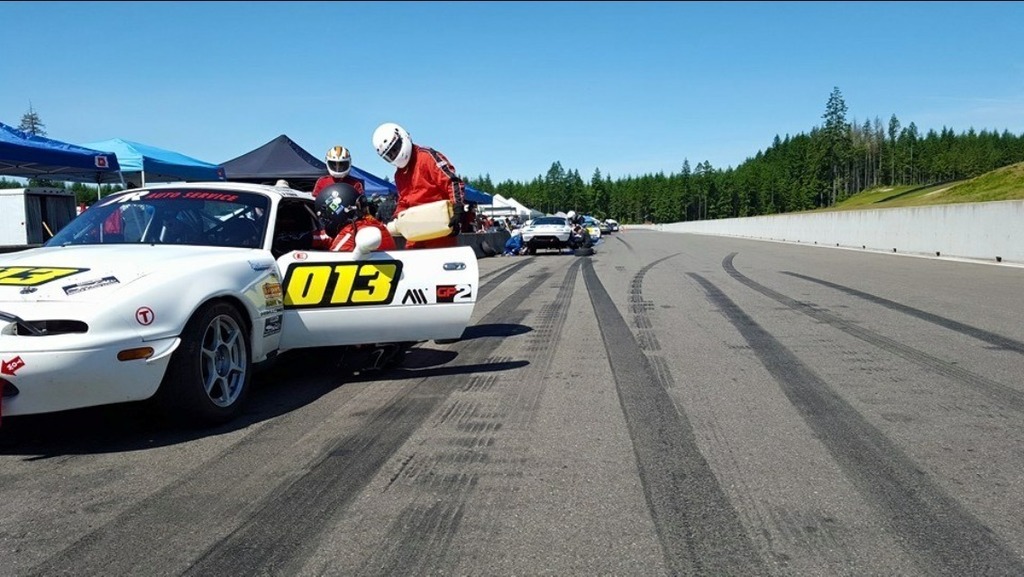
WRL: no practice or qualifying, classed with hp/wt. Can be moved up or down via lap times or begging. No time restraint on pit stops, and can ONLY switch drivers while fueling.
LDRL: no practice, 10-20 minutes qualifying before the first race. Classed via qualifying, and can be moved up or down via lap times or begging. 5 minute minimum pit stop when fueling, no one can be in the car, so we just had the driver pop out and open the fuel cap, that way it avoided any penalties. Once the egg timer you picked up at pit in is beeping, the grab it and release you.
For example: we were in LDRL B class in the wet, but once it dried out and we starting out pacing all but the top 3-4 cars, we were bumped up to A. Shame, because it was A: my fast laps, and B: although our times were good, our straight line speeds were laughable compared to the top ~5.
Our car: NA6 with stock VVT engine, wiring harness, and MS3pro ecu, AMR suspension, 1.8 brakes with Cobalt pads, Yoko AD08, 949 lw flywheel, stock cluch, 5speed, torsen, kosei K1s. Hunsinger quick fuel jugs.
Formula for reliability and awesomeness: The above with a slightly better clutch. Cobalts and VVT are a requirement. Everything else is obviously interchangeable with similar equipment.
But I'd highly suggest avoiding stock clutches, 1.6 brakes, open diffs, bilstein suspension, turbos, stock clutches, and regular fuel jugs.
This is only my experience from 32 hours of racing, your results may vary.
And yes, they're essentially Lemons/Chump officials that were tired of the gimmicky bull **** and just wanted to race. They still have a LOT of fun over the course of the weekend, but the main focus is on safety and racing.

WRL: no practice or qualifying, classed with hp/wt. Can be moved up or down via lap times or begging. No time restraint on pit stops, and can ONLY switch drivers while fueling.
LDRL: no practice, 10-20 minutes qualifying before the first race. Classed via qualifying, and can be moved up or down via lap times or begging. 5 minute minimum pit stop when fueling, no one can be in the car, so we just had the driver pop out and open the fuel cap, that way it avoided any penalties. Once the egg timer you picked up at pit in is beeping, the grab it and release you.
For example: we were in LDRL B class in the wet, but once it dried out and we starting out pacing all but the top 3-4 cars, we were bumped up to A. Shame, because it was A: my fast laps, and B: although our times were good, our straight line speeds were laughable compared to the top ~5.
Our car: NA6 with stock VVT engine, wiring harness, and MS3pro ecu, AMR suspension, 1.8 brakes with Cobalt pads, Yoko AD08, 949 lw flywheel, stock cluch, 5speed, torsen, kosei K1s. Hunsinger quick fuel jugs.
Formula for reliability and awesomeness: The above with a slightly better clutch. Cobalts and VVT are a requirement. Everything else is obviously interchangeable with similar equipment.
But I'd highly suggest avoiding stock clutches, 1.6 brakes, open diffs, bilstein suspension, turbos, stock clutches, and regular fuel jugs.
This is only my experience from 32 hours of racing, your results may vary.
#485
WRL and Lucky Dog Racing are both awesome. A lot of the cars are still junky looking, but the newer builds are nice. I've competed in four 8 hour enduros, the first two had zero contact the entire race, the 2nd two had small amounts of contact due to heavy rain.
And yes, they're essentially Lemons/Chump officials that were tired of the gimmicky bull **** and just wanted to race. They still have a LOT of fun over the course of the weekend, but the main focus is on safety and racing.

WRL: no practice or qualifying, classed with hp/wt. Can be moved up or down via lap times or begging. No time restraint on pit stops, and can ONLY switch drivers while fueling.
LDRL: no practice, 10-20 minutes qualifying before the first race. Classed via qualifying, and can be moved up or down via lap times or begging. 5 minute minimum pit stop when fueling, no one can be in the car, so we just had the driver pop out and open the fuel cap, that way it avoided any penalties. Once the egg timer you picked up at pit in is beeping, the grab it and release you.
For example: we were in LDRL B class in the wet, but once it dried out and we starting out pacing all but the top 3-4 cars, we were bumped up to A. Shame, because it was A: my fast laps, and B: although our times were good, our straight line speeds were laughable compared to the top ~5.
Our car: NA6 with stock VVT engine, wiring harness, and MS3pro ecu, AMR suspension, 1.8 brakes with Cobalt pads, Yoko AD08, 949 lw flywheel, stock cluch, 5speed, torsen, kosei K1s. Hunsinger quick fuel jugs.
Formula for reliability and awesomeness: The above with a slightly better clutch. Cobalts and VVT are a requirement. Everything else is obviously interchangeable with similar equipment.
But I'd highly suggest avoiding stock clutches, 1.6 brakes, open diffs, bilstein suspension, turbos, stock clutches, and regular fuel jugs.
This is only my experience from 32 hours of racing, your results may vary.
And yes, they're essentially Lemons/Chump officials that were tired of the gimmicky bull **** and just wanted to race. They still have a LOT of fun over the course of the weekend, but the main focus is on safety and racing.

WRL: no practice or qualifying, classed with hp/wt. Can be moved up or down via lap times or begging. No time restraint on pit stops, and can ONLY switch drivers while fueling.
LDRL: no practice, 10-20 minutes qualifying before the first race. Classed via qualifying, and can be moved up or down via lap times or begging. 5 minute minimum pit stop when fueling, no one can be in the car, so we just had the driver pop out and open the fuel cap, that way it avoided any penalties. Once the egg timer you picked up at pit in is beeping, the grab it and release you.
For example: we were in LDRL B class in the wet, but once it dried out and we starting out pacing all but the top 3-4 cars, we were bumped up to A. Shame, because it was A: my fast laps, and B: although our times were good, our straight line speeds were laughable compared to the top ~5.
Our car: NA6 with stock VVT engine, wiring harness, and MS3pro ecu, AMR suspension, 1.8 brakes with Cobalt pads, Yoko AD08, 949 lw flywheel, stock cluch, 5speed, torsen, kosei K1s. Hunsinger quick fuel jugs.
Formula for reliability and awesomeness: The above with a slightly better clutch. Cobalts and VVT are a requirement. Everything else is obviously interchangeable with similar equipment.
But I'd highly suggest avoiding stock clutches, 1.6 brakes, open diffs, bilstein suspension, turbos, stock clutches, and regular fuel jugs.
This is only my experience from 32 hours of racing, your results may vary.
#486
Thread Starter
Elite Member
iTrader: (4)
Joined: Mar 2008
Posts: 6,301
Total Cats: 696
From: Granbury, TX
I picked up a set of the new Bauer extended lower balljoints on the recent group buy. Just put them in and got a fresh setup.
This is the point, extension from the mount to the ball joint stud = more track and more camber:

Even though I had part of the first lot of ball joints, it still had the markings that NASA requires for tech. I "think" these ball joints end up being 2 points due to track change and the ability to run wider tires as compared to offset upper bushings.

Changing ball joints on a Miata is laughably easy. Basically 2 nuts and a bolt. Did both sides in under an hour.
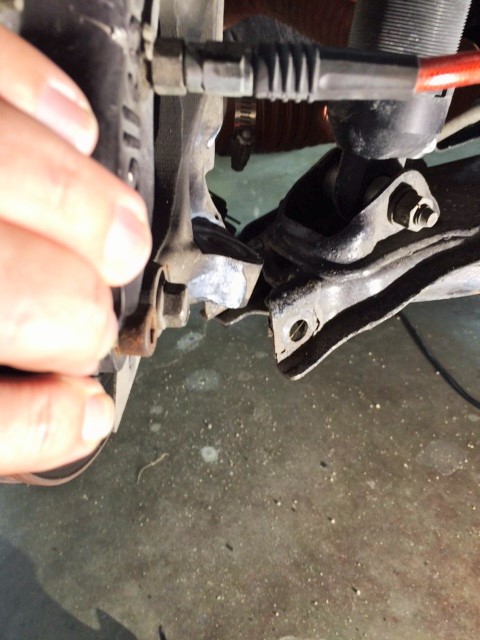
In the past, I found the hardest part of the lower balljoint change to be popping the balljoint. Always involved a BFH wielded at odd angles with stuff in the way (working on jackstands). So I got this tool from Harbor Freight. Worked great. As with all Made in China stuff, lubricate before use:
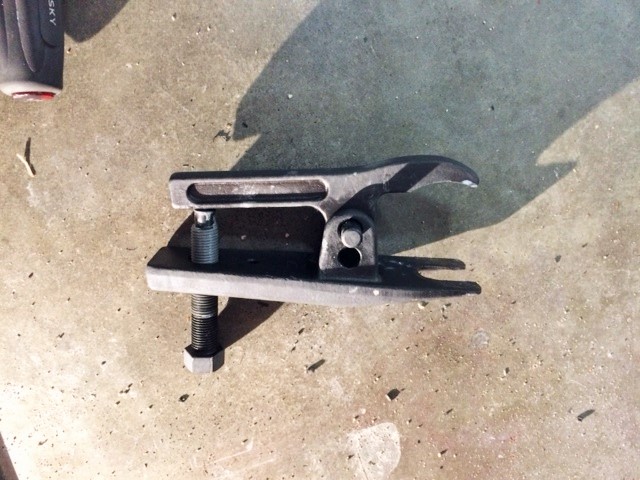
Now the gotcha' for those of you driving to a shop for setup/alignment. If you had 2.5 degrees or more camber on 225 tires before putting these in, it is likely that your tires will be hitting your springs once you set the car on the ground -- so go ahead and twist your suspension bolts to take camber out while it's up in the air.
How did it work? Great. We were able to dial in a solid 3.5 degrees of camber into the front of an NA at 4.7" pinch height with adjustment to spare. Everything has good clearance for the suspension to work. I took it out on track on some dead RS-3's and got within 1.3 seconds of my PB on R-Comps. The car felt a lot looser (loose is fast), which means the front is gripping better. I've been struggling with premature front tire wear at the outer edge -- so I'm looking forward to improved tire life. Set of sticker Toyo RR's are in the garage waiting to go on . . . .
This is the point, extension from the mount to the ball joint stud = more track and more camber:

Even though I had part of the first lot of ball joints, it still had the markings that NASA requires for tech. I "think" these ball joints end up being 2 points due to track change and the ability to run wider tires as compared to offset upper bushings.

Changing ball joints on a Miata is laughably easy. Basically 2 nuts and a bolt. Did both sides in under an hour.

In the past, I found the hardest part of the lower balljoint change to be popping the balljoint. Always involved a BFH wielded at odd angles with stuff in the way (working on jackstands). So I got this tool from Harbor Freight. Worked great. As with all Made in China stuff, lubricate before use:

Now the gotcha' for those of you driving to a shop for setup/alignment. If you had 2.5 degrees or more camber on 225 tires before putting these in, it is likely that your tires will be hitting your springs once you set the car on the ground -- so go ahead and twist your suspension bolts to take camber out while it's up in the air.
How did it work? Great. We were able to dial in a solid 3.5 degrees of camber into the front of an NA at 4.7" pinch height with adjustment to spare. Everything has good clearance for the suspension to work. I took it out on track on some dead RS-3's and got within 1.3 seconds of my PB on R-Comps. The car felt a lot looser (loose is fast), which means the front is gripping better. I've been struggling with premature front tire wear at the outer edge -- so I'm looking forward to improved tire life. Set of sticker Toyo RR's are in the garage waiting to go on . . . .

Last edited by hornetball; 01-24-2016 at 01:23 PM.
#487
Our current build version 2.0 includes a Racing Beat header, and some a slightly more optimized VVT head. I am experimenting with a K&N intake. this should all yield a consistent WHP level. Additionally, the car gets a "crusher" style front end and some rear aero.
The schedule should allow for a minimum of 4, max of 7 races.
The schedule should allow for a minimum of 4, max of 7 races.
#488
Thread Starter
Elite Member
iTrader: (4)
Joined: Mar 2008
Posts: 6,301
Total Cats: 696
From: Granbury, TX
I had just gotten the tires warmed up (around 6:00), and . . .
It was coolant on track. When I looked in the rear view to come back on, there was a huge cluster**** going on behind me.
It was coolant on track. When I looked in the rear view to come back on, there was a huge cluster**** going on behind me.
Last edited by hornetball; 02-08-2016 at 04:28 PM.
#493
Thread Starter
Elite Member
iTrader: (4)
Joined: Mar 2008
Posts: 6,301
Total Cats: 696
From: Granbury, TX
I'm thinking about playing with aero though.
As you well know.

Thank you, BTW.
I instruct for The Driver's Edge and Apex up here. Sign up for an event. It's a great track.
#495
Thread Starter
Elite Member
iTrader: (4)
Joined: Mar 2008
Posts: 6,301
Total Cats: 696
From: Granbury, TX
Ooooooohhhh!!! Famous last words.
Decided to do some Spring cleaning on Red. Change the oil, change friction discs and pads, regrease the suspension, blah, blah.
But, as I got into it, found problems. One of the front hubs was crunchy, so swapped it out with a new Mazda OEM spare from my track box. No big deal, kind of expected.
On to the rears. Pulled the brake disks and took a look at the hubs . . . HOLY F***ING S***:
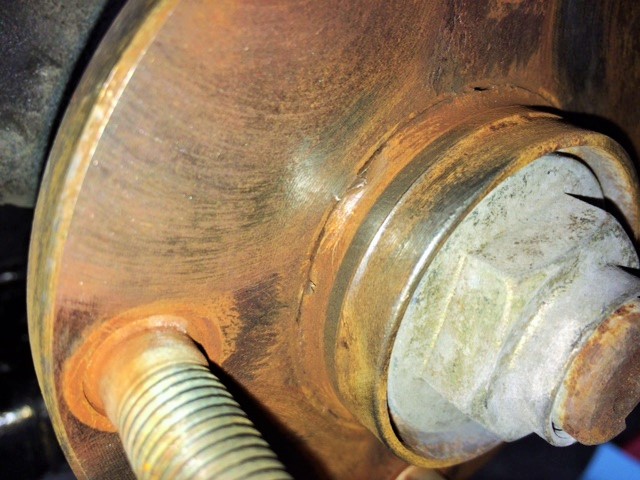
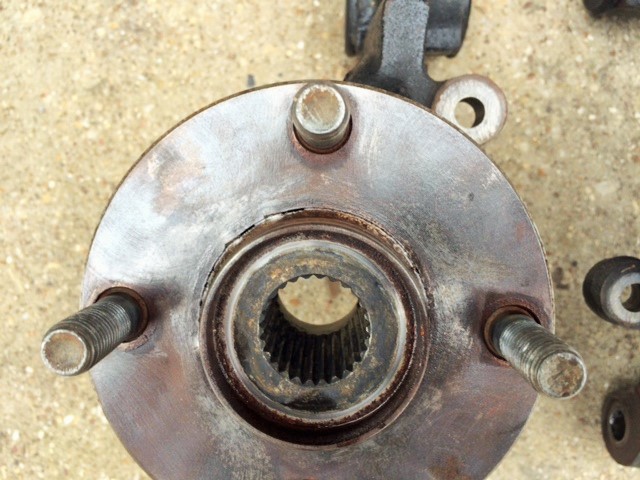
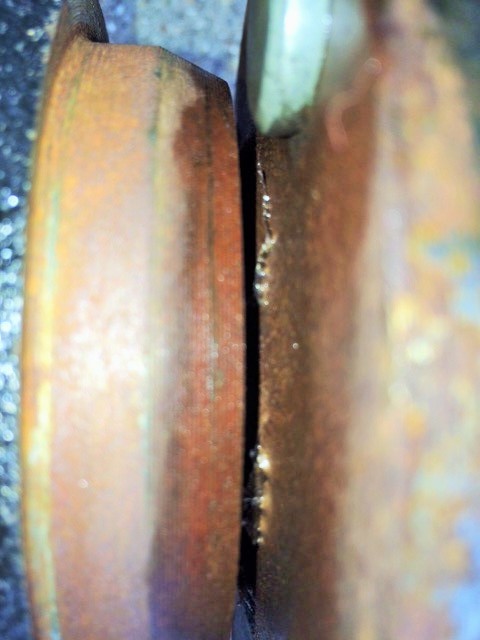
Both sides had circumfurential cracks all the way around. On the passenger side, the cracking was only evident on the outside. But on the driver's side, cracks had gone all the way through. I honestly have no idea why this didn't launch a wheel -- but I'd rather be lucky . . . .
This can be serious. See https://www.miataturbo.net/race-prep...ar-hubs-72613/. Here's a vid to peak your interest.
And, the car wasn't done with me. I had been having belt squeal on startup, so I decided to tighten the WP/ALT belt. What I found was a cracked WP alternator ear.
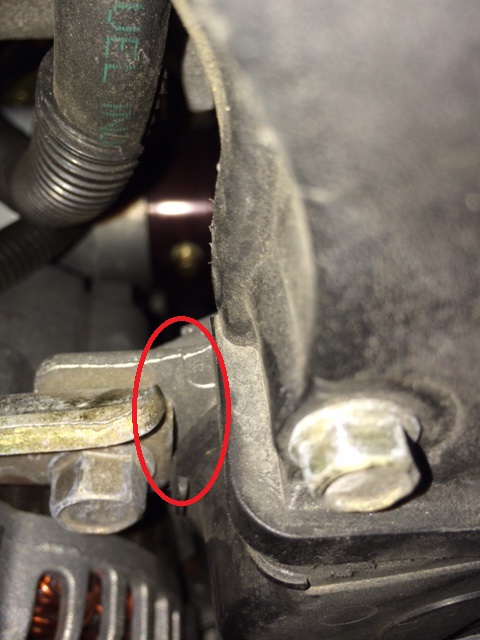
So, here we go again . . . .:

Upon inspecting the WP, there sure isn't much material there to support the alternator. This is a cheap, Chinese WP that comes in those engine rebuild DNJ kits. Lesson learned.
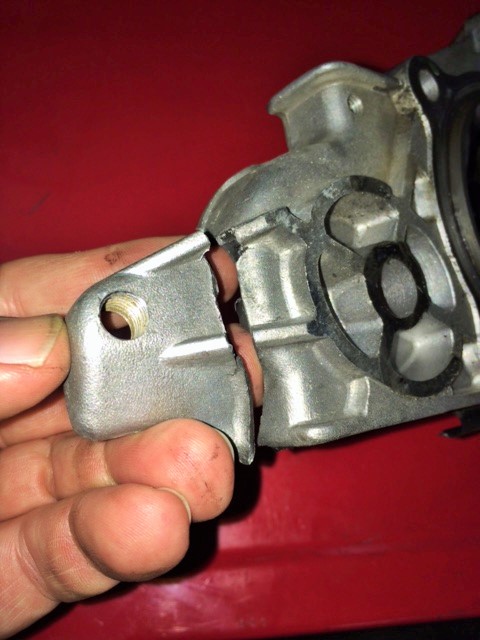

Parts on order. I have an out-of-town track event next weekend. It's going to be tight.
Decided to do some Spring cleaning on Red. Change the oil, change friction discs and pads, regrease the suspension, blah, blah.
But, as I got into it, found problems. One of the front hubs was crunchy, so swapped it out with a new Mazda OEM spare from my track box. No big deal, kind of expected.
On to the rears. Pulled the brake disks and took a look at the hubs . . . HOLY F***ING S***:



Both sides had circumfurential cracks all the way around. On the passenger side, the cracking was only evident on the outside. But on the driver's side, cracks had gone all the way through. I honestly have no idea why this didn't launch a wheel -- but I'd rather be lucky . . . .
This can be serious. See https://www.miataturbo.net/race-prep...ar-hubs-72613/. Here's a vid to peak your interest.
And, the car wasn't done with me. I had been having belt squeal on startup, so I decided to tighten the WP/ALT belt. What I found was a cracked WP alternator ear.

So, here we go again . . . .:

Upon inspecting the WP, there sure isn't much material there to support the alternator. This is a cheap, Chinese WP that comes in those engine rebuild DNJ kits. Lesson learned.


Parts on order. I have an out-of-town track event next weekend. It's going to be tight.
Last edited by hornetball; 02-22-2016 at 12:20 PM.
#496
1.6 alternator bracket cut down for weight savings, 1.6 water pump, and a shorter idler pulley bolt. Might solve your problem.
Although I cut this off a vvt swap since I didn't have the 1.8 bracket to use with the 1.8 water pump, and it was pretty beefy if I remember correctly. Might be ok with a better pump? I've never seen any difference besides spot welded vs cast impeller.
Although I cut this off a vvt swap since I didn't have the 1.8 bracket to use with the 1.8 water pump, and it was pretty beefy if I remember correctly. Might be ok with a better pump? I've never seen any difference besides spot welded vs cast impeller.
#498
No it's a separate bracket off the side of the block, not the water pump at all.
You can cut the brace and rear bolt off.
http://www.ebay.com/ulk/itm/like/182...3D985896788041
You can cut the brace and rear bolt off.
http://www.ebay.com/ulk/itm/like/182...3D985896788041














